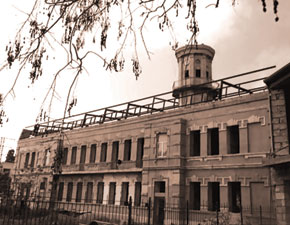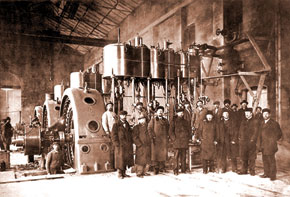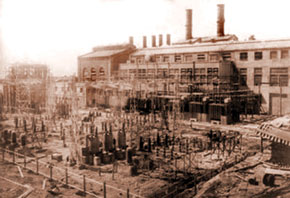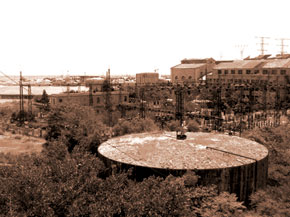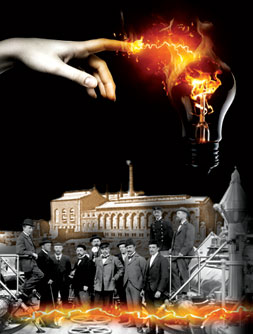 Pages 56-60
Pages 56-60By Rustam K. Alasgarov
Azerbaijan’s first electric power station was put into operation in July 1901; it was based at Bibi Heybat, just south of Baku and was followed by another plant, built at the other end of the city, one year later. We trace the development of a power now taken for granted but more than ever a vital part of everyday life
The Caucasus and Mercury Steamship Company, navigating the River Volga and the Caspian Sea, was first to use electricity in Baku in 1880, to install electric lamps at their passenger terminal. These lamps were lit daily at twilight and burned until dawn, giving off a dim light to the delight of Bakuvians. More passengers flocked to the Caucasus and Mercury and the quay itself became a favourite promenade for the townspeople.
Shamsi Asadullayev – a larger than life oil magnate - could not ignore such a response. He immediately acquired his own electricity generator and hired foreign specialists to service it. The generator provided light for his multi-storey mansion in the centre of the city.
Following Shamsi Asadullayev, the German Richard Sorge, owner of machine workshops in the Balakhani oil fields (he was the uncle of the legendary Soviet intelligence officer Richard Sorge) was one of the first to acquire a small electricity generator for manufacturing purposes.
According to the Baku Administrative Board’s Information on Electricity Generation in Baku City, 1895-1903, the first electricity generator in Baku was installed in 1895 at Baku Dock on the Bayil Highway. The electricity was produced by a German Allgemaine dynamo. By 1903 there were already more than 70 small electricity generators.
Even bathhouses
Of course, capacity-wise they were much less productive than equipment installed later, nevertheless they did produce enough electrical energy for their purpose. Thus the development of an electricity supply began in Baku. Numerous factories, oil fields, companies, various societies, hotels and even bathhouses had their own generators. Some, normally located in the city centre, had one or two dynamos, usually produced in Germany (by Siemens & Galske, Allgemaine, Gramma, Otto Deutsch, Schuckert, Volat, Laval and others). Their capacity was not very great – from 65 to 250 volts, from 27 to 250 amperes - and in appearance they were nothing like contemporary models.
Electricity was instantly popular. Numerous small-capacity electricity generators emerged everywhere. One such, comprising 3 steam machines and with a capacity of 42 kilowatts, was built in 1882 at the Nobel Brothers’ oil refinery. In 1897 its capacity was increased to 550 kilowatts.
Two years later, Baku businessmen joined forces with Absheroni oil field and refinery owners and collected substantial funds. A conference of Baku oil businessmen and the Siemens company decided to use the money raised to construct fixed, centralized electric power stations, to the same capacity as European and even American stations. They were to be installed on the border between the Bayil and Bibi-Heybat districts of the time, as well as at the intersection of the city (White City) with the oil producing outskirts – Black City.
Thus, Baku branches of Electric Power, a Berlin joint-stock society, opened on 21 January 1899. The society was a branch of the Electric Lighting Society of 1886, owned by the Siemens and Galske company. The company undertook financing, design and prospecting work, as well as construction and the procurement of equipment and materials.
Baku patron and millionaire Haji Zeynalabdin Taghiyev was a member of Electric Power’s board of directors. Formally, however, the founders of the society were from the aristocracy – Baron Wrangel, Count I. Golenishev-Kutuzov-Tolstoy, acting state councillor V. Golubev – they embodied the firm’s significance and respectability. The society’s charter was immediately confirmed at a meeting of Baku shareholders and the principal capital came from local stockholders and French contributions totalling 4 million gold roubles.
Alongside the foreign capital, there was an increasing share of local capital, represented by Baku’s greatest entrepreneurs: Zeynalabdin Taghiyev, Musa Naghiyev, Isa Bey Hajinsky, Shamsi Asadullayev, Murtuza Mukhtarov and others.
The society’s administration was first located in Berlin, then in Petersburg and, in 1907, it was moved to Baku.
Electric Power engineers A.Davidov and R.Klasson were seconded from the Petersburg administration to Baku at the end of 1899 to study the scope of outstanding works, calculate expenses and assess the efficiency of work and expenditure. They prepared a detailed report with the following summary:
Electric Power’s range of activity is quite extensive and capital allocated in current conditions must bring in a good income. However, this depends on not losing time and on solving the question of applying motors to all phases of oil acquisition, especially to well boring, as this is currently the only technical challenge process. There is no doubt that with a favourable resolution, electricity will eventually replace steam and Electric Power will face the pleasant necessity of increasing the power output of their stations… As for lighting, from the financial point of view we should assume that this area of business will not be unprofitable for Electric Power, even considering the competition – the existing rather high prices will fall.
This report, qualified and supported by detailed fiscal calculation, coincided with the positive expectations of the leaders of Siemens and Galske.
Electric Power had no time to lose, so they immediately began intensive preparations for large-scale work. They obtained the ‘highest permission’ for a lease of territory to construct the power station, they negotiated with various institutions, oil businessmen, entrepreneurs and the city’s administrative board. And they began recruiting a large number of employees, including highly qualified specialists from European countries and Russia. No obstacles came from government; they also agreed to lay a railway and a quay on the sites under construction.
Moving mountains
By 1900 the board of the Baku department had already prepared a qualified report. After project approval, Siemens and Galske began the construction of two electric stations simultaneously: one on the southern shores of Absheron Peninsula, near the foot of Bibi-Heybat mountain and the second in the White City. The charter capital raised amounted to four million golden roubles.
Robert Eduardovich Klasson, director of the office for electrical-technical facilities in the Baku region, managed the work. He noted in his diary:
We are dreaming of filling up the sea, if we get approval, then the Bibi-Heybat power station will be located in the best spot in all Baku – it will be surrounded by water on three sides.
Klasson was from a family of Swedes who had become naturalised Russians. He was an electrical engineer and had previously worked at the hydroelectric power plant in the Okhtinskaya powder mills in Petersburg. He was a liberal, embraced social-democratic ideas for a while and convened Marxist groups in his Petersburg apartment. Lenin met his wife-to-be Krupskaya there.
Moving to Baku, Klasson recruited experienced and respected engineers to his administration. His chief assistant in Baku was Leonid Borisovich Krasin, who later became a prominent Soviet leader and diplomat. Krasin worked on the construction of two electric power stations in Baku until 1 July 1904. Later he actually managed all the construction and finishing works, although he was a chemical engineer. He learned construction skills on the building of the Siberia and Baikal railways.
In 1925, shortly before Krasin’s death, the New Moscow publishing house issued his book Story of Past Days, in which he spoke warmly of his time in Baku:
I remember four intense years of work in Baku with great gratitude. We threw a big part of Mount Bayil into the sea, expanding the area available for the power station by almost twenty times, reclaiming it from the sea. And we erected there the great building for the central electric power station. We worked with American speed, the construction site was crowded with workers and people of every standing. I think people on the site spoke 12 or 15 languages; besides Germans, Danes, English and other European workers and engineers, we also had Persians, Tartars, Lezghis, Ossetians, Abkhaz, Georgians and others… The main aim of the enterprise was to provide the fields with electricity and to use it for boring and baling. Even though the technicians were sceptical, almost hostile, predicting failure for the new electrical method, we, half-dozen young engineers, worked as pioneers… we laid the foundations for the scientific electrification of the oil industry.
They worked non-stop to the schedule designed by Klasson and Krasin. Siemens and Galske worked with Germanic discipline. The site and machine halls were constructed with a view to building more powerful machinery in the future and increasing production. The Kaspiy (Caspian) newspaper wrote:
Rush, frantic rush… traction engines desperately whistle, puff and hoot in different corners of the construction area, cranes scurry here and there. There are foremen milling around everywhere, tugs with barges on tow-ropes manoeuvre near the shore. Thunderous noise and thousands of people everywhere… However behind this seeming chaos, there is order and a wise, directing hand.
The beautiful buildings of the two power stations were constructed in just over a year. Their wide interiors were lit by windows on two sides and by lamps. Field auxiliary workshops were completed at the same time – administrative buildings, waterworks, residential houses (these were climate adjusted – the rooms were cool in summer and warm in winter), a hostel for workers, railways, quays, spacious yards, asphalted paths and roads, lawns with flowers.
Switch-on
The test launch of the Bibi-Heybat power station was held early in July 1901 and it went into full-time service a week later. One year later, the White City power station, which supplied electricity to the oil fields in Sabunchi and the oil refinery in Black City, was put into operation. A desalination plant was installed in the power station to produce steam for the turbines from salt water. The electricity from the White City and Bibi-Heybat power stations was used in baling, boring and repairing wells in the oil fields, in mechanical workshops and plants, for water and oil pumps and, naturally, for lighting.
However, the main consumers of its output were the leading oil field and oil refining companies. Over 50 per cent of the electricity produced was consumed by the Nobel Brothers Association and the Caspian and Black Seas Oil and Trading Society of Baron Rothschild. Electric Power was also involved in the cable industry in the oil fields, producing transmission lines, and installing electric motors. Engines working wells and drill borings, pumps and workshops, were fitted with generators capable of producing 2-thousand-volts, quite a courageous and innovatory solution at the time.
A Siemens report on Electric Power’s work in Baku said:
… The total number of motors connected to the Society’s power stations at the end of 1906 exceeded 300…
Ahead of the US
By 1913 there were already 1,184. In 1916 1,638 of the 3,750 bore wells functioning in Absheron were supplied with electricity - almost 50 per cent. At the same time, no more than 18-20 per cent of the oil fields in the USA were electrified.
Both power stations were upgraded over time. In 1904 electricity production had tripled compared to the launch year of 1902. But this was still not enough to meet demand from industry in Absheron. A letter sent in June 1904 from Baku to the board of the Joint Stock Society in Petersburg said:
The current situation in the oil field, one of great demand for electrical energy… compels us to take all possible measures to increase the working capacity of the White City power station.
From May 1905, expanding both stations, the Society installed two turbines of 2200 kilowatts each in White City. They had also installed additional 1600-kilowatt turbines in Bibi-Heybat. Both Siemens-Schuckert and Siemens and Galske received big orders to produce and deliver equipment.
There was further expansion of the White City power station in 1909-1910. They simultaneously enhanced the overhead and cable networks and installed over 60 transformers and distribution hubs in the Balakhany, Ramana and Surakahny fields.
In 1913 the Bibi-Heybat power station also had to be upgraded, because its reserves were completely exhausted. The White City power station was connected to Bibi-Heybat via an overhead high tension line. Transformer substations were built, following the example of Absheron Peninsula.
The power stations expanded their capacities continuously until Russia and Germany joined the First World War.
Big city lights
Bibi-Heybat and White City provided many of the city’s residential blocks with lighting.
Before the First World War, 110.8 million kilowatt hours were produced per year in Absheron Peninsula; this ranked Baku as third Russian city, behind only Petersburg and Moscow.
Thus, from the archives of the administrative board of Baku city, we read a report On the lighting situation in Baku city, dated 12 March 1914:
… the Administrative Board is proud to announce the following. The streets of Baku city are lit mainly by kerosene lamps. There are 4,972 of them and they are located in both central streets and the city’s outskirts. As well as kerosene lamps, there is also electric lighting. The sources of electric light are arc lamps and heating lamps. There are 16 arc lamps and they are located on the central streets of Nikolaevskaya, Mikhaylovskaya, and Velikoknyajeskiy Avenue (now Istiqlaliyyat, Medeniya and Alovsat Guliyev). These lamps are of alternating current, 8-A each. The boulevard is lit by heating lamps; 116 fittings, each of 300 candle power. All 116 fittings are located on 37 columns. 5 of them have 4 fittings, the other 32 have 3 fittings each. Kerosene lamps burn all night. The number of hours they are alight is designated by the so-called lighting calendar, designed by the city administrative board in 1885, which shows every day separately and exactly when the lamps will be on and off. On moonlit nights the lamps are not on, however in the case of cloud, fog, rain or snow the kerosene lamps are lit on moonlit nights as well…
At that time the Siemens and Galske Baku joint-stock society advertised a novelty: the Votan electric lamp with cable wire, providing 70 per cent economy of energy, one-watt from 5 to 50 candle power, and from 20 to 240 volts.
The Siemens shops and offices were located on the corner of Gogol and Birjevaya Streets (now Uz. Hajibeyov Street). Opposite Molokan Garden (now Khagani), they also advertised electrical equipment of all types; power transmission, electrification of equipment, lighting and ozone treatment of water and air. They also offered induction meters, heating devices, electrical devices for cleaning the pipes of water boilers, a vast variety of steel fittings for lighting, electric machinery and many other items. They also offered an assortment of medical instruments, including x-ray machines, alarm and telephone systems etc. From their very first days the Electric Power society was in competition with already existing companies: the Light, the Absheron and the Caspian-Black Sea Society. However, Electric Power began to dominate the electrical industry in Absheron. It owned power stations in the city, along with the city’s lighting network, and power stations in White City, Balakhany and Bibi-Heybat.
The Electric Power joint-stock society was central to the development of the energy industry in Azerbaijan. The society, with a huge capital base, used new technology and produced cheaper electricity.
With the branch of Siemens, it was liquidated after the arrival of the 11th Red Army by decree of the Azerbaijani Revolutionary Committee dated 12 June 1920. Both companies were nationalised. Thanks to those two mighty Siemens power stations, which were highly durable (Bibi-Heybat was renamed the Krasin State Regional Electricity Station (GRES) and the one in White City to Red Star), Baku never suffered a shortage of electricity even after the destruction of the Civil and World wars, which left the whole of Soviet Russia in ruins. It is quite remarkable that the further reconstruction and modernization of Baku’s two main power stations was carried out by the Leningrad (now Petersburg) plant of Electric Power – once Siemens’ leading enterprise in Russia.
Sources and literature
1. Baku newspaper. 6 November 1902
2. State History Archive of the Republic of Azerbaijan:
F. 582, bordereau.1.case
F. 130, B,1. C.25.
F.92,B,1. C. 29,185, 313, 422, 1045, 1075.
F.528, B1, C, 2, 8, 22,28, 56, 63, 66, 69, 81, 106, 126, 151, 164, 205, 232, 274, 280, 357, 408, 516
3. Caucasus diaries. Tbilisi, 1871, 1873, 1878, 1882, 1885, 1886, 1907, 1910
4. Kamenetskiy M.O. The First Russian electric power stations. M.-L., 1951
5. Krasin L.B. Story of the past days. New Moscow, 1925
6. Robert Eduardovich Klasson. M.-L., 1963
About the author: Rustam Alasgarov is an employee of the State History Archive of the Republic of Azerbaijan and author of articles on aspects of Azerbaijani history.
